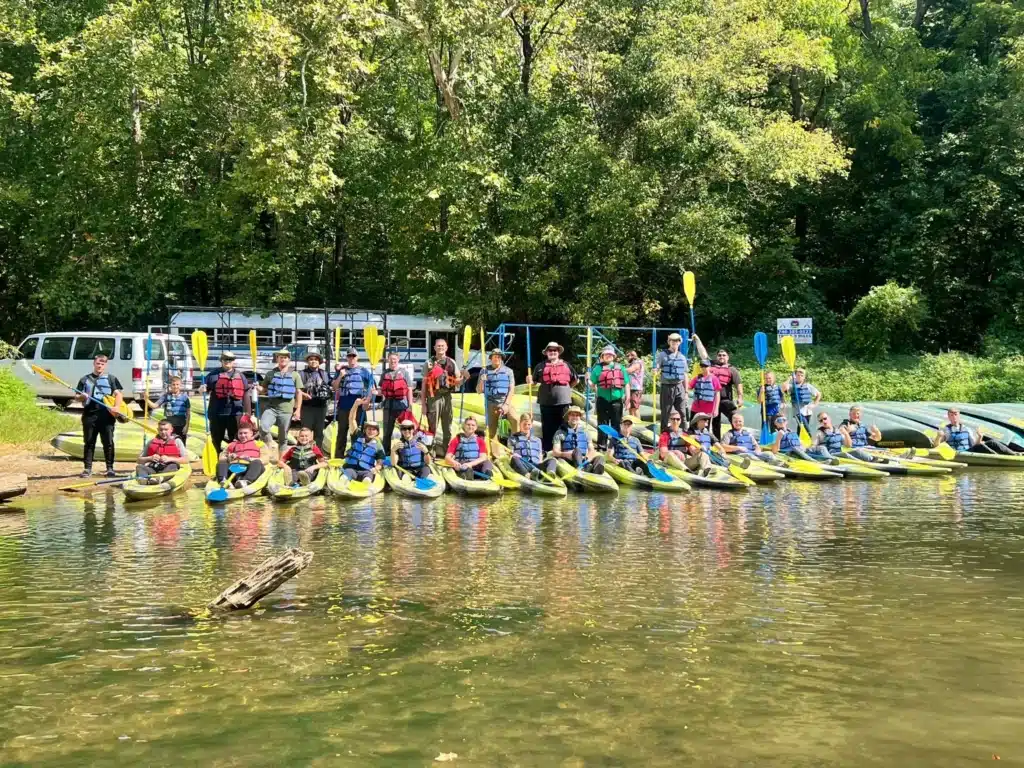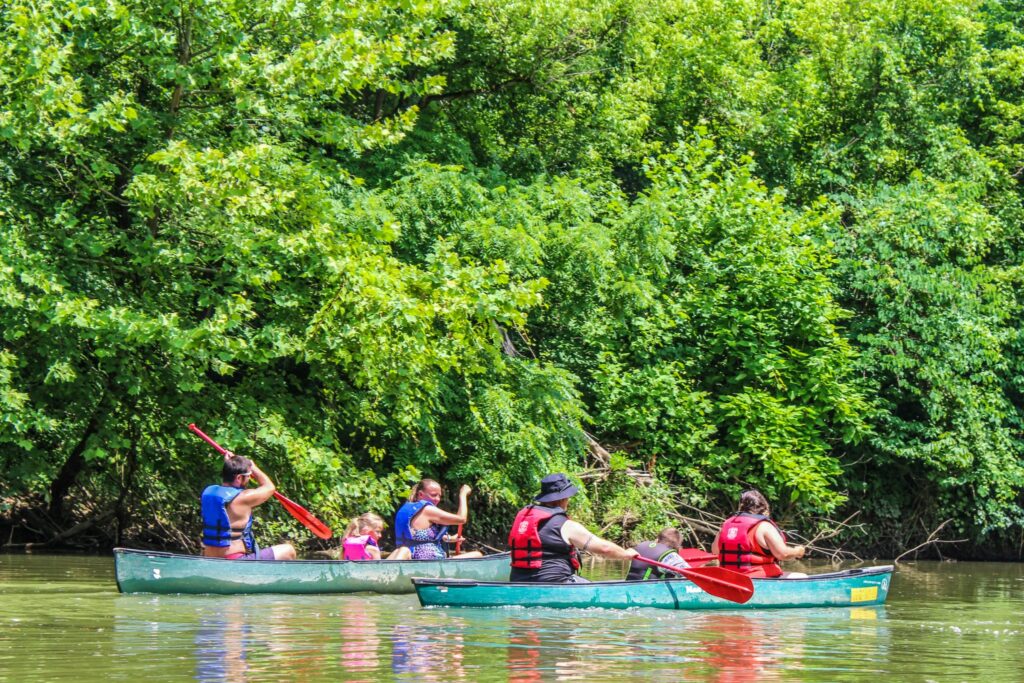
Family-Friendly River Trips: Canoeing, Kayaking, Rafting & Tubing on the Hocking Hills River
Whether you’re a seasoned paddler or a curious novice, few experiences rival the joy of drifting down the Hocking Hills River with friends and family. From the gentle currents perfect for canoeing and kayaking to the exhilarating moments of rafting, and the laid-back vibe of tubing, there’s an outdoor adventure waiting for every group. At Hocking Hills Canoe Livery, we specialize in crafting family-friendly trips and group fun that blend nature, excitement, and safety. Ready to chart a course for memories? Let’s dive in.
Planning Your Family-Friendly Canoe Excursion
Embarking on a canoeing journey with loved ones is a delightful way to bond, explore nature, and build confidence on the water. When planning a family-friendly trip, consider these key factors:
Selecting the Right Route Length
5-Mile Float: Ideal for younger children or first-timers, this stretch takes roughly 2–3 hours at a leisurely pace. It includes gentle riffles and scenic meanders, offering plenty of opportunities to spot wildlife.
7-Mile Float: Perfect for slightly older kids and families seeking a longer adventure, the 7-mile trip typically lasts 3–4 hours. Expect a mix of calm sections and mild rapids that add a dash of excitement without being overwhelming.
Choosing Appropriate Canoes and Gear
Stable Family-Size Canoes: Our canoes accommodate up to four paddlers, two adults and two children, ensuring stability and room for snacks, life jackets, and a small cooler.
Personal Flotation Devices (PFDs): We provide USCG-approved PFDs in various sizes. Proper fit is crucial, kids should wear PFDs snugly to prevent slipping.
Dry Bags: Keep electronics, extra clothes, and picnic items dry. We offer dry bag rentals to safeguard your belongings against unexpected splashes.
Safety Briefing & Instruction
Before hitting the water, our friendly guides conduct a comprehensive river safety overview. Topics include basic paddle strokes, what to do if you capsize, and how to recognize changing currents on the Hocking Hills River.
Children and first-time paddlers practice “heel lifts” (a technique to stabilize the canoe) and learn how to assist in navigation—turning an outing into an educational experience.
Packing Essentials
Sunscreen & Hats: Sun exposure on open water is intense; opt for SPF 30+ and wide-brimmed hats.
Water & Snacks: Plan for at least one liter of water per person and easy-to-eat, non-messy snacks like trail mix or granola bars.
Layered Clothing: Even on warm days, mornings can be cool. Dress in moisture-wicking layers, and consider quick-dry materials in case someone gets splashed.
By tailoring your trip length, equipment, and preparations to your family’s experience level, you set the stage for a safe and gratifying canoe adventure.
Kayaking with Kids: Tips for a Smooth Paddle
For families who crave a bit more independence on the water, kayaking can be an exceptional choice. Single or tandem kayaks allow each paddler more control, and children often revel in steering their own craft. To ensure everyone has a blast:
Selecting the Right Kayak Type
Sit-On-Top Kayaks: These are excellent for beginners, offering stability and easy entry/exit, ideal for young paddlers.
Tandem Kayaks: If your child is too young to control a kayak solo, tandem models let a parent handle steering while the child enjoys paddling under supervision.
Learning Basic Paddling Techniques
Forward Stroke & Back Paddle: Teach kids how to generate forward momentum and how to reverse to avoid obstacles.
Sweep Stroke: A wide, arcing stroke helps steer the kayak, a fun skill that helps children feel accomplished.
Bracing & Wet Exit: In shallow sections, practicing how to brace prevents capsizing. A wet exit (safe self-ejection) gives confidence if the kayak tips over.
Managing Expectations on the Hocking Hills River
River Currents & Eddy Lines: Calm eddies behind rocks allow rest spots. Point out how the current flows, children love seeing the subtle dance of water around obstacles.
Mild ‘Rapids’: Many sections resemble Class I-II rapids, waves that splash without demanding advanced maneuvers. Encourage kids to lean forward and maintain a firm grip on their paddle.
Family-Friendly Safety Practices
Buddy System: Pair children with adults in tandem kayaks or keep them in your sight if they’re paddling solo.
Hand Signals: Establish simple signs for “stop,” “help,” and “all clear” to maintain communication, especially when the noise of moving water makes verbal cues tricky.
Frequent Rest Breaks: Plan stopovers at accessible riverbanks. Build in time to stretch legs, reapply sunscreen, and snack, keeping energy levels high and spirits positive.
Kayaking can feel wonderfully empowering for young paddlers. By providing hands-on instruction and emphasizing fun, you’ll foster confidence and a love for outdoor adventures that lasts a lifetime.
Rafting as a Group: Building Teamwork & Memories
Nothing says “group fun” like a shared rafting experience. While the Hocking Hills River doesn’t host extreme whitewater, many family groups relish the camaraderie of navigating mild rapids together. Here’s how to ensure a successful family or group rafting trip:
Choosing the Right Raft Type
Standard Inflatable Rafts: Accommodating 4–6 paddlers, these rafts balance stability with maneuverability.
Multi-Person Rafts: Larger rafts for extended families or school groups allow up to 8 paddlers, perfect for group rentals or team-building outings.
Understanding Crew Roles & Commands
Front Paddlers: Set the pace and rhythm with synchronized strokes.
Rear Paddlers: Steer the raft using reverse sweep strokes and paddle commands, “Forward Paddle,” “Hold Fast,” and “Back Paddle.”
Captain Role: Designate an adult or experienced paddler to call commands. Clear, concise calls keep everyone moving in unison and improve control in slightly swifter currents.
Safety Gear & Procedures
Life Jackets & Helmets: Mandatory for everyone, regardless of swimming ability. Ensure PFDs fit snugly and helmets are adjusted properly.
Throw Bag & Rescue Rope: Keep these within arm’s reach. In the unlikely event someone falls overboard, practice a few self-rescue and team-rescue drills before launching.
Wet Exits & Paddle Rescue: Teach older children and teens how to perform a wet exit and help flip a raft or kayak back upright.
Rapids & River Conditions on Hocking Hills
Class I-II Sections: Suitable for families, gentle waves that provide excitement without overpowering young paddlers.
Scouting Rapids: At designated quiet spots, pause on the bank to survey upcoming rapids. Point out hazards, strainers (fallen logs) or low-head dams, and determine the best line for your raft.
Team-Building & Bonding
Shared Responsibilities: Assign switching roles mid-trip; kids can try steering in calm sections under supervision.
Group Challenges: Time how quickly the raft passes between two points, encouraging friendly competition and strategy.
On-Shore Activities: Combine rafting with a picnic or short hiking detours to waterfalls, turning the day into a full outdoors festival.
Rafting on the Hocking Hills River reinforces teamwork, communication, and shared accomplishments, ideal for extended families, scout troops, or corporate retreats seeking group fun.
Tubing for a Laid-Back Outdoor Float
If simple relaxation atop the water is your family’s style, tubing offers minimal paddling with maximum chill. Here’s how to transform an ordinary float into an unforgettable family outing:
Selecting Durable Tubes & Safety Gear
Heavy-Duty River Tubes: Choose tubes with built-in handles and smooth collars, easier for smaller children to grip.
PFDs for Tubers: Even on calm sections, wearing PFDs is non-negotiable, especially if a tube flips unexpectedly.
Entry & Exit Strategies
Gentle Launch: Enter from a shallow ramp or designated put-in point. Teach kids how to hold onto the tube’s handles before stepping into deeper water.
Exit Points: Identify safe, sandy banks for disembarking; avoid rocky or steep riverbanks that pose slipping hazards.
Drift Comfortably While Observing Nature
River Topography: The Hocking Hills River weaves through forested valleys, offering glimpses of bald cypress, Sycamore trees, and occasional river otters.
Natural Rest Stops: Pull over at gravel bars or shallow eddies to stretch, snack, and explore river flora, kids love “rock hopping” and examining interesting finds like fossilized rocks or unusual shells.
Anchoring for Picnics & Short Breaks
Portable Anchor Bags: Small sand- or water-filled bags keep your float in place while you enjoy a snack break.
Group Lounging: Once anchored, let everyone recline on their tubes, enjoying calm water as you share stories and laughter.
Combining Tubing with Other River Activities
Swim & Snorkel Sections: Certain deeper pools beckon through careful wading, supervised swimming provides a refreshing break from drifting.
Nearby Canoeing or Kayaking Excursions: If someone craves a more active adventure, mix tubing with a short kayaking or canoeing leg, splitting into small groups adds variety.
By focusing on rest, relaxation, and simple joys, sunny stretches on the water, spotting bass or bluegill, and chatting with floating companions, tubing becomes a mellow complement to more dynamic activities like rafting and kayaking.
Ensuring River Safety for All Ages

Regardless of your chosen activity, canoeing, kayaking, rafting, or tubing, prioritizing river safety is paramount. At Hocking Hills Canoe Livery, we emphasize a culture of preparedness:
Life Jackets Fit & Function Check
Proper Fit for Children: A poorly fitted PFD can slip off, verify chest straps and crotch straps are snug.
Adult PFD Adjustments: Adults should tighten waist and shoulder straps, ensuring the device rides high on the torso without restricting breathing.
Understanding River Currents & Hazards
Reading the Water: Teach families to spot eddies (calm pockets behind rocks) for rest, and to avoid strainers, fallen trees or branches that allow water through but trap boats.
Identifying Hydraulics (“Holes”): Powerful recirculating currents near obstructions can trap paddlers. If caught, lean forward, paddle hard, and angle downstream to escape.
Communicating on the Water
Hand Signals: Agree on simple signals for “stop,” “help,” “move left/right,” and “all clear.” Water noise often renders shouting ineffective.
Buddy System: Pair younger paddlers with an adult in tandem kayaks or nearby canoes. Teach children to check on one another periodically rather than drifting apart.
Weather Awareness & Seasonal Considerations
Thunderstorm Precautions: Always check local weather forecasts before launching. If storms approach, darkening clouds, sudden wind gusts, exit the river immediately.
Water Temperature: Even in summer, river water can be cool. Hypothermia risk increases if someone falls in; carry spare dry clothes in a waterproof bag.
First-Aid & Emergency Preparedness
First-Aid Kit: Our livery provides kits containing bandages, antiseptic wipes, and insect bite relief. Consider adding waterproof sunscreen, blister pads, and tweezers for tick removal.
Emergency Contacts: Save Hocking Hills Canoe Livery’s number (740-385-0523) and note closest hospital or urgent-care facilities. We also equip every group with a whistle for quick signaling.
By embedding these river safety practices into your adventure, you minimize risks and ensure every family member feels secure, transforming your Hocking Hills River experience into a confident exploration.
Making It an Educational Outdoors Experience
In addition to thrills, river outings can double as hands-on learning opportunities, especially for families with school-age children:
Aquatic Ecology & Wildlife Observation
Riparian Zones: Point out plant species, Sycamore trees, river mosses, and willows, that stabilize riverbanks. Discuss how these plants prevent erosion and support local ecosystems.
Wildlife Spotting: Look for blue herons, kingfishers, and turtles basking on logs. Provide a simple field guide or use a nature app so kids can identify birds, fish, and amphibians on the spot.
Geology & Rock Formations
Fossil Hunting: Shallow gravels along the Hocking Hills River occasionally reveal ancient snail or brachiopod fossils. Let children carefully search for and photograph (but not remove) these relics.
Sediment Layers: Pause on gravel bars to examine sediment layers: coarse gravel, sand, and silt illustrate how rivers deposit materials over time.
Hands-On STEM Activities
Water Speed Experiment: Use a floating stick or small object to measure time taken to travel between two points. Calculate approximate current speed using length/time.
Water Quality Testing: Bring a simple test kit to measure pH or turbidity, teaching children about the importance of clean waterways. Compare results to known healthy ranges.
Historical & Cultural Context
Early Settlers & Native American History: Share stories of how indigenous tribes and early pioneers relied on river systems for transportation, fishing, and sustenance.
Local Folklore: The Hocking Hills area abounds with legends, describe waterfall legends or tell tales of early river boatmen, enriching the trip with local lore.
By weaving educational elements into your river excursion, you foster curiosity and turn a leisurely float into an immersive outdoor classroom, combining fun with genuine learning.
Group Fun: Making Memories on the Hocking Hills River

Few activities bring extended families, scouts, church groups, or school outings closer than a shared trip down the river. Consider these ideas to amplify group fun:
Themed Outing Days
Treasure Hunt Float: Beforehand, discretely anchor waterproof “treasure tokens” (brightly colored stones or plastic coins) near easy-to-reach riverbanks. As children pass, challenge them to spot and collect tokens, rewarding successful hunters with small prizes at the end.
Wildlife Bingo: Create bingo cards featuring animals spotted along the river, turtle, heron, deer, crayfish. The first paddler to complete a line wins a fun treat or bragging rights.
Team-Building Challenges for Teens & Adults
Relay Races: In a safe, calm section, set up short races, tandem kayak vs. tandem kayak, or canoe vs. canoe. Emphasize teamwork and paddling coordination.
Bridge-Crossing Strategy: At designated shallow bars, have groups plan and execute a safe crossing of a small constructed “bridge” of logs or rocks, discussing weight distribution and river safety tactics.
Picnic & On-Shore Games
Family Potluck Picnic: Pack easy-share dishes, sandwiches, fruit platters, and finger foods. Use a group interface like a dry bag picnic pack to keep items organized and dry.
Cornhole or Frisbee: Many Hocking Hills Canoe Livery launch spots have grassy areas perfect for tossing a frisbee or playing lawn games once you’ve beached your rafts or canoes.
Documenting Your Adventure
Group Photos & Video Montage: Assign a designated photographer, rotate members so everyone appears in at least one group shot. Capture slow-motion videos of paddles splashing or serene sweeping wide-angle river shots, ideal for sharing on social media.
Trip Journal or Scrapbook: Encourage older kids and teens to jot down highlights, first rapids conquered, wildlife seen, or favorite snack breaks. Later, compile photos and notes into a digital or physical scrapbook.
Whether your crew numbers four or forty, structuring activities around shared goals, like reaching a picnic spot by noon, cements bonds and creates stories that families and friends recount for years.
What to Pack for a Family River Trip
A successful family-friendly trip depends on thoughtful packing. Beyond PFDs and paddles, consider these essentials:
Clothing & Personal Gear:
Quick-Dry Clothing: Synthetic materials wick moisture and dry fast, ideal for unexpected splashes.
Water Shoes or Sandals: Neoprene booties or sturdy sandals with straps protect feet from sharp rocks and offer traction on slippery surfaces.
Sun Protection: Broad-brimmed hats, UV-blocking sunglasses, and reef-safe sunscreen (SPF 30+) applied every two hours.
Safety & First-Aid Kit:
Basic First-Aid Supplies: Bandages, antiseptic wipes, insect bite relief, and blister bandages.
Emergency Whistle: Secured to each PFD, whistles help signal for assistance if separated from the group.
Compact Repair Kit: Duct tape, a small multi-tool, and extra rope allow quick fixes to gear or improvised pull-start solutions.
Food & Hydration:
Reusable Water Bottles: Plan for at least 1 liter of water per person for every two hours on the river.
Non-Perishable Snacks: Trail mix, energy bars, granola bites, and dry fruit keep hunger at bay without creating garbage.
Cooler or Insulated Bag: Store sandwiches, fresh fruit, and drinks. Place the cooler in the center of a canoe or secure it in a raft with waterproof straps.
Extras for Fun & Comfort:
Binoculars & Field Guide: For birdwatching and identifying local flora.
Waterproof Phone Case: Protect your phone for candid photos and emergency calls, although you may lose cell service in some remote river sections.
Light Blanket or Beach Towel: Perfect for impromptu riverside rest stops or as a picnic base.
Packing thoughtfully ensures you’re prepared for Hocking Hills River conditions, turning your canoeing, kayaking, rafting, or tubing trip into a seamless, stress-free adventure.
Concluding Thoughts & Your Next Steps
A river excursion on the Hocking Hills River offers the perfect mix of outdoors exploration, family-friendly thrills, and educational moments. From tranquil tubing floats to spirited rafting and tranquil kayaking or canoeing, there’s an activity tailored to every age and skill level. By prioritizing thorough river safety, packing wisely, and incorporating group-focused games and learning opportunities, you’ll create lasting memories for your traveling and adventure-seeking crew.
Reach out to us if you have any questions or need assistance planning your next river adventure. Call 740-385-0523, or visit our website, https://hockingriver.com/ for more information: Hocking Hills Canoe Livery. We’re conveniently located in Logan, Ohio.
For additional details on equipment rentals, safety protocols, and frequently asked questions, explore our services at Hocking Hills Canoe Livery Services and check our FAQ: Hocking Hills Canoe Livery FAQ.
Paddle smart, stay safe, and savor every moment on the Hocking Hills River, because nothing brings families and friends closer than a shared adventure on the water!

